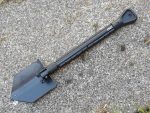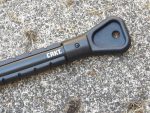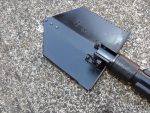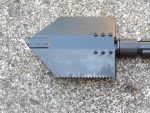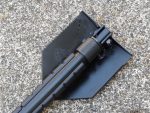If you stop and think about it, everything I cover on our website, be it knives, guns, or water filters, are tools. They’re tools for survival in one shape or another. Many people simply look at a knife or a gun and consider them as “weapons”, and they are. However, they are still tools designed for specific tasks. Some firearms are designed for self defense, some are designed for hunting, and some are designed for target shooting. The same goes for knives; some are for self defense or everyday use, some for dressing out game, and some for use around the kitchen. So, don’t limit your thinking to expect that everything we cover and test are weapons. They are first and foremost tools, designed for specific tasks. Some are for multiple tasks.
I was ten or eleven years old when my step-father took me to an Army/Navy Military Surplus store in Chicago. Back in those days, about the only military surplus you ran across was U.S. military items. There weren’t any military surplus items from other countries, for the most part. I still remember my step-father buying me a genuine, U.S. military folding entrenching tool (shovel), and it was a WWII design, which is still popular today. I also got a pistol belt with a canteen/cover and a first-aid pouch, to wear on the pistol belt, and the ol’ fashioned “Castro” fatigue cap. I was ready to go to war at that tender age. I’ve always had an interest in military surplus, especially US military surplus, which is getting harder and harder to find these days, due to some regulations passed by former Presidents. Most military surplus is sold, given away to our allies, or simply destroyed these days, instead of allowing us, taxpayers, the opportunity to purchase it. What a waste!
When I joined the military in 1969, we were issued the new tri-fold, folding shovel in Infantry School that was more compact than the older style WWII folding shovel we were issued in Basic Training. I thought that the new tri-fold shovel was a better design because it was easier to pack on a pistol belt, and more compact. However, it simply didn’t cut it in my humble opinion, over the original WWII designed entrenching tool that I grew up with.
Today, there are so many poorly made tri-fold entrenching tools on the market, it just makes my head spin. Most are just junk. You use use it once, and it breaks on you, simple as that. I’ve seen them for as little as $5, and remember, you don’t always get what you pay for. In this case, if you believe you are getting a “genuine” US military tri-fold entrenching tool for $5, you are in for a surprise. Don’t waste you money on cheap junk.
I was more than a little intrigued when I spotted the www.crkt.com CRKT “Trencher” in their 2016 catalog, and placed an order for one – and it arrived several months later. I don’t know why some (many?) companies advertise products in their new catalogs, and then they don’t have them in-stock for months and months, sometimes, even a year later, then again, I’m not in marketing any longer, so I guess they know what they are doing.
At first glance, the CRKT Trencher reminds me of my old WWII genuine surplus entrenching tool that I received when I was a kid. And, to be sure, my entrenching tool was genuine US military surplus and not a knock off or a cheap clone, like the ones you find today.
From the information in the CRKT catalog, it appears that the Trencher must have been designed in-house, as there is no one listed in the catalog or on their website as the designer. Let’s clear the air. The Trencher is manufactured in China. However, this is NO piece of junk. Trust me on this! The Trencher’s blade is manufactured out of 1050 carbon steel with a Rockwell hardness of 40-45, and this is a good hardness on a steel that is going to be used for chopping and digging. Anything harder and the blade will chip and break under that kind of hard-use.
The length of the spade is 7.85 inches, which is about par for an entrenching tool. The edge of the blade has two edges– one for cutting, which can be sharpened easy enough, and one has a saw blade on it. Plus, the tip of the spare is reinforced for digging through tough stuff. You have no worries about the tip bending or breaking if you hit rocks. Overall length of the Trencher is just over 27-inches when opened, and the spade head closes fully for carry in the included case, or it can be opened and lock halfway, for serious digging. The handle material is two-fold, it is made out of carbon steel and is reinforced with Polypropyline Nylon on either side of the handle – we are talking strong!
The butt end of the Trencher has a wide polypropylene head on it, for a much better hold than the WWII entrenching tool. I like it a lot. There is also a hole in the poly head. I don’t quite know what it is used for, but it is there. The spade can be locked in three different positions– completely closed and locked, halfway open and locked, and fully open and locked, and it locks up solid with the twisting motion of the lock.
The Trencher comes in a black ballistic nylon sheath, and it is a bit different than most sheaths I’ve seen with entrenching tools. First off, the tool is removed from the bottom of the sheath, instead of through the top. It is secured by two straps, each one having two snaps. There is no way the tool is going to fall out of the sheath. Secondly, the sheath has a pocket on the top that is also secured with a cover than has two snaps on it. The pocket can be used to carry quite a bit of survival gear, which is something I haven’t seen with any other entrenching tool sheath . Nice job, CRKT! There are also straps on the back for attaching the sheath/tool to your MOLLE gear. The tool is too long to attach to the front of your combat vest, so it will do on the side or the rear, or it can be attached to a pack. However, there is no method for attaching the set-up to a belt. That’s too bad!
One thing we never have a lack of, in the western part of Oregon, are blackberry vines. They are not native to Oregon, but they took off like you wouldn’t believe. Blackberries are free for the picking, come the end of August and into September, if you care to fight the large thorns on the blackberry vines which are wicked! I usually test knives on these vines to see if a knife is sharp enough to slice through a vine with one felled swoop. With the Trencher, I took a different approach to see how well the entrenching tool would dig into the ground and cut the blackberry vines where they begin. The Trencher had no problem digging through the roots of the vines. We also have ground that has nothing but rocks, big and small, under the soil. It is next to impossible to start digging without hitting rocks in short order. I didn’t do a lot of digging, but I did enough to know just how tough the Trencher is. I hit lots of rocks, but the tip of the spade wasn’t damaged in the least. The saw side of the spade was used to saw through some dead tree branches. The things worked great. I’ve tested other entrenching tools with a saw blade on one side of the spade that didn’t do well at all, when it came to sawing through wood.
You can easily toss the Trencher in your Bug Out Bag, or keep it in the trunk of your vehicle, in the event you need to chop, cut, or dig your way through something, or dig your way out of deep snow. The whole setup weighs a little more than three pounds, which is a bit heavier than other entrenching tools, but the weight is needed on this heavy-duty tool. It is about as bullet proof as they come. It would make a great addition to your survival supplies.. Full retail on the Trencher is $99.99, and you can find CRKT deeply discounted if you shop on the ‘net. Yeah, it’s a lot of money, but you are getting a top-notch entrenching tool– one that will never let you down and will last a lifetime. As I’ve said many times, don’t waste your money on junk. If you do, you will be buying junk over and over again. With the CRKT Trencher, it will be the last entrenching tool you’ll ever need. It is “that” tough.
– Senior Product Review Editor, Pat Cascio










